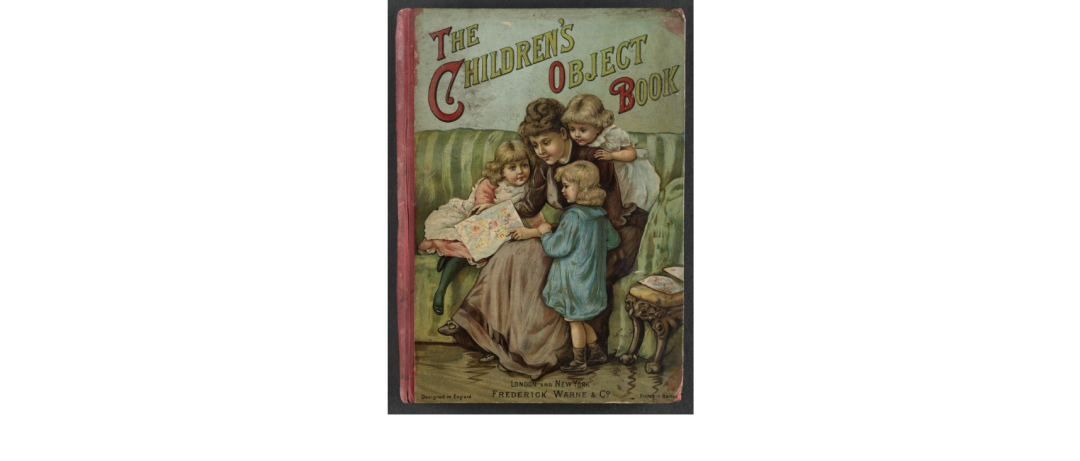
While browsing the Library of Congress’ website, I found several interesting historical sources. However, one thing that stood out to me in specifically was a picture book titled “The children’s object book.” As an education major, I found this particularly interesting, as what children were being taught is a direct reflection of society at this time. When analyzed closely, the detailed illustrations, text, and selection of information provided in the book gives readers a glimpse into what life was like for children, families, and other members of society in this period.
The book was written in London and published in New York City by Frederick Warne. Although an exact date is not available, it is known that the book was published sometime in the 1880’s, which was during the Gilded Age. As historian David Shi notes, “The Gilded Age was an era marked by the greed of the newly rich as they flaunted their enormous personal wealth. Many of them used their wealth to finance extensive political bribery and corporate corruption”.[1] This period signified economic prosperity, a boom in urban life, and numerous job opportunities. The drastic change in society had a significant impact on family and home life as well. Family dynamics, as well as expectations of people’s roles in the home changed. David Shi later notes that “The flood of people into cities brought changes in daily life and increased opportunities for recreation and leisure. Middle- and upper-class families, especially those who had moved to streetcar suburbs often spent free time together at home, singing around a piano, reading, or playing games – cards, dominoes, backgammon, chess, and checkers”.[2] Much of this information is reflected and can be found in the book, indicating that it was targeted for the upper and middle class. For example, on page 5 there is an illustration of a ‘drawing room’, which shows a piano, book, and other activities like those mentioned above. Additionally, there is an actual ‘library’ included on the page.[3] Another indication of this is that there can be chefs and maids seen in the kitchen on page 7.3 It was very common for wealthy families to have butlers, maids, chefs, and other forms of assistance in their homes during this time. Some employees even had their own living quarters, which can be found in historic homes built during this time.[4]
Although the book primarily targets upper- and middle-class children, it also shows other aspects of society. For example, page 8 is titled ‘The Railroad’ and illustrates objects commonly found at a train station including a railway engine, telegraph post, and lamp.3 The Gilded Age was known for many technological and electrical advancements, which makes sense why this would be featured in this book. Although the gilded age had a focus on upper and middle class, people still struggled financially, with many having their child work as an extra source of income. “Over a quarter of all families contained gainfully employed children in the 1880, 1900, and 1910 censuses, and around a fifth contained gainfully employed children in the 1920 census”.[5] This can also be seen in the illustrations within the book, as on page 14 we see children working and using tools on a farm. Many of these tools are labeled below, to educate the reader about them.3 This is also supported in Daniel Walkowitz’ work, which states “children entered the mills in their early teen and left in their twenties”.[6] Given the historical context, the variety of items, and scenes illustrated in the book, it is evident that the its purpose educate children about the society and world around them, which it seems to have effectively done.
Footnotes:
[1] David E, Shi. “Political Stalemate and Rural Revolt”. America: A Narrative History (Vol. 2). 12th ed. W.W. Norton and Company. 2022. (accessed November 13, 2023).
[2] David E, Shi. “Changes in Culture and Thought”. America: A Narrative History (Vol. 2). 12th ed. W.W. Norton and Company. 2022. (accessed November 13, 2023).
[3] Frederick Warne , Publisher, and Juvenile Collection. The Children’s Object Book. [London ; New York: F. Warne & Co., 188-?] Pdf. https://www.loc.gov/item/42048867/ .
[4] Catherine, Dean. 2006. “In service and beyond: Domestic work and life in a gilded age mansion.”/From morning to night: Domestic service in maymont house and the gilded age south. The Journal of American History 93, (1) (06): 150-152, https://www.proquest.com/scholarly-journals/service-beyond-domestic-work-life-gilded-age/docview/224891447/se-2 (accessed November 13, 2023).
[5] Carolyn Marie, Moehling. 1996. Work and family: Intergenerational support in american families, 1880–1920. Ph.D. diss., Northwestern University, https://www.proquest.com/dissertations-theses/work-family-intergenerational-support-american/docview/304277479/se-2 (accessed November 13, 2023).
[6] Daniel J, Walkowitz. 1972. Working-class women in the gilded age: Factory, community and family life among cohoes, new york cotton workers. Journal of Social History 5, (4) (Summer): 464, https://www.proquest.com/scholarly-journals/working-class-women-gilded-age-factory-community/docview/1297407508/se-2 (accessed November 6, 2023).
